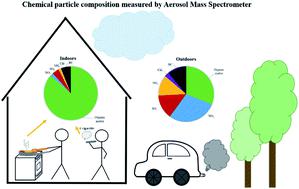当前位置:
X-MOL 学术
›
Environ. Sci.: Processes Impacts
›
论文详情
Our official English website, www.x-mol.net, welcomes your feedback! (Note: you will need to create a separate account there.)
Cooking and electronic cigarettes leading to large differences between indoor and outdoor particle composition and concentration measured by aerosol mass spectrometry.
Environmental Science: Processes & Impacts ( IF 5.5 ) Pub Date : 2020-05-07 , DOI: 10.1039/d0em00061b Yuliya Omelekhina 1 , Axel Eriksson 2 , Francesco Canonaco 3 , Andre S H Prevot 3 , Patrik Nilsson 1 , Christina Isaxon 1 , Joakim Pagels 1 , Aneta Wierzbicka 1
Environmental Science: Processes & Impacts ( IF 5.5 ) Pub Date : 2020-05-07 , DOI: 10.1039/d0em00061b Yuliya Omelekhina 1 , Axel Eriksson 2 , Francesco Canonaco 3 , Andre S H Prevot 3 , Patrik Nilsson 1 , Christina Isaxon 1 , Joakim Pagels 1 , Aneta Wierzbicka 1
Affiliation

|
We spend about two thirds of our time in private homes where airborne particles of indoor and outdoor origins are present. The negative health effects of exposure to outdoor particles are known. The characteristics of indoor airborne particles, though, are not well understood. This study assesses the differences in chemical composition of PM1 (<1 μm) inside and outside of an occupied Swedish residence in real time with a High-Resolution Time-of-Flight Aerosol Mass Spectrometer (HR-ToF-AMS) and an Aethalometer. The chemical composition and concentration of particles indoors showed large differences compared to outdoors. The average indoor concentration was 15 μg m−3 and was higher than the outdoor 7 μg m−3. Organics dominated indoor particle composition (86% of the total mass) and originated from indoor sources (cooking, e-cigarette vaping). The average indoor to outdoor ratios were 5.5 for organic matter, 1.0 for black carbon, 0.6 for sulphate, 0.1 for nitrate, 0.2 for ammonium and 0.2 for chloride. The occupancy time accounted for 97% of the total measured period. Four factors were identified in the source apportionment of organic particle fraction by applying positive matrix factorization (PMF): two cooking factors, one e-cigarette factor and one outdoor contribution (OOA) organic factor penetrated from outside.
中文翻译:

烹饪和电子烟会导致室内和室外的微粒组成和通过气溶胶质谱法测量的浓度之间存在巨大差异。
我们将大约三分之二的时间都花在存在室内和室外空气传播颗粒的私人住宅中。暴露于室外颗粒对健康的负面影响是已知的。但是,室内空气中颗粒物的特性尚未得到很好的理解。这项研究使用高分辨率飞行时间气溶胶质谱仪(HR-ToF-AMS)和溶度计实时评估了瑞典居住住宅内部和外部PM1(<1μm)的化学成分差异。与室外相比,室内的化学成分和颗粒浓度差异很大。室内平均浓度为15μgm -3,高于室外7μgm -3。有机物占室内颗粒组成的主要部分(占总质量的86%),并且来源于室内(烹饪,电子烟雾化)。室内与室外的平均比例分别为:有机物5.5,黑碳1.0,硫酸盐0.6,硝酸盐0.1,铵0.2和氯化物0.2。占用时间占总测量时间的97%。通过应用正矩阵因式分解(PMF)在有机物颗粒物的来源分配中确定了四个因素:两个烹饪因素,一个电子烟因素和一个从外部渗透的室外贡献(OOA)有机因素。
更新日期:2020-06-24
中文翻译:

烹饪和电子烟会导致室内和室外的微粒组成和通过气溶胶质谱法测量的浓度之间存在巨大差异。
我们将大约三分之二的时间都花在存在室内和室外空气传播颗粒的私人住宅中。暴露于室外颗粒对健康的负面影响是已知的。但是,室内空气中颗粒物的特性尚未得到很好的理解。这项研究使用高分辨率飞行时间气溶胶质谱仪(HR-ToF-AMS)和溶度计实时评估了瑞典居住住宅内部和外部PM1(<1μm)的化学成分差异。与室外相比,室内的化学成分和颗粒浓度差异很大。室内平均浓度为15μgm -3,高于室外7μgm -3。有机物占室内颗粒组成的主要部分(占总质量的86%),并且来源于室内(烹饪,电子烟雾化)。室内与室外的平均比例分别为:有机物5.5,黑碳1.0,硫酸盐0.6,硝酸盐0.1,铵0.2和氯化物0.2。占用时间占总测量时间的97%。通过应用正矩阵因式分解(PMF)在有机物颗粒物的来源分配中确定了四个因素:两个烹饪因素,一个电子烟因素和一个从外部渗透的室外贡献(OOA)有机因素。


























 京公网安备 11010802027423号
京公网安备 11010802027423号